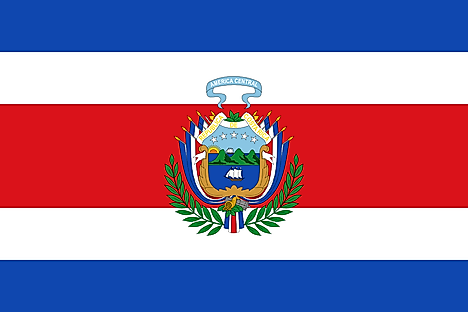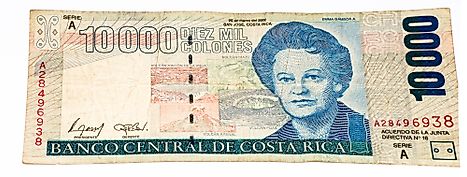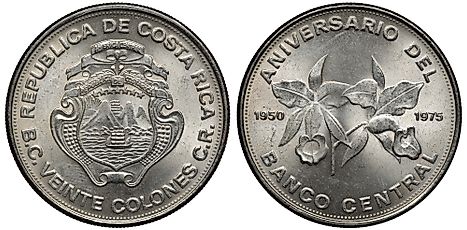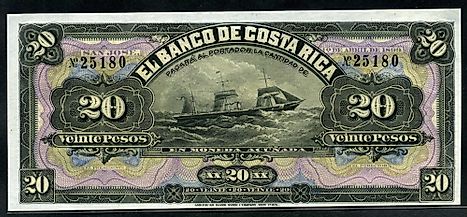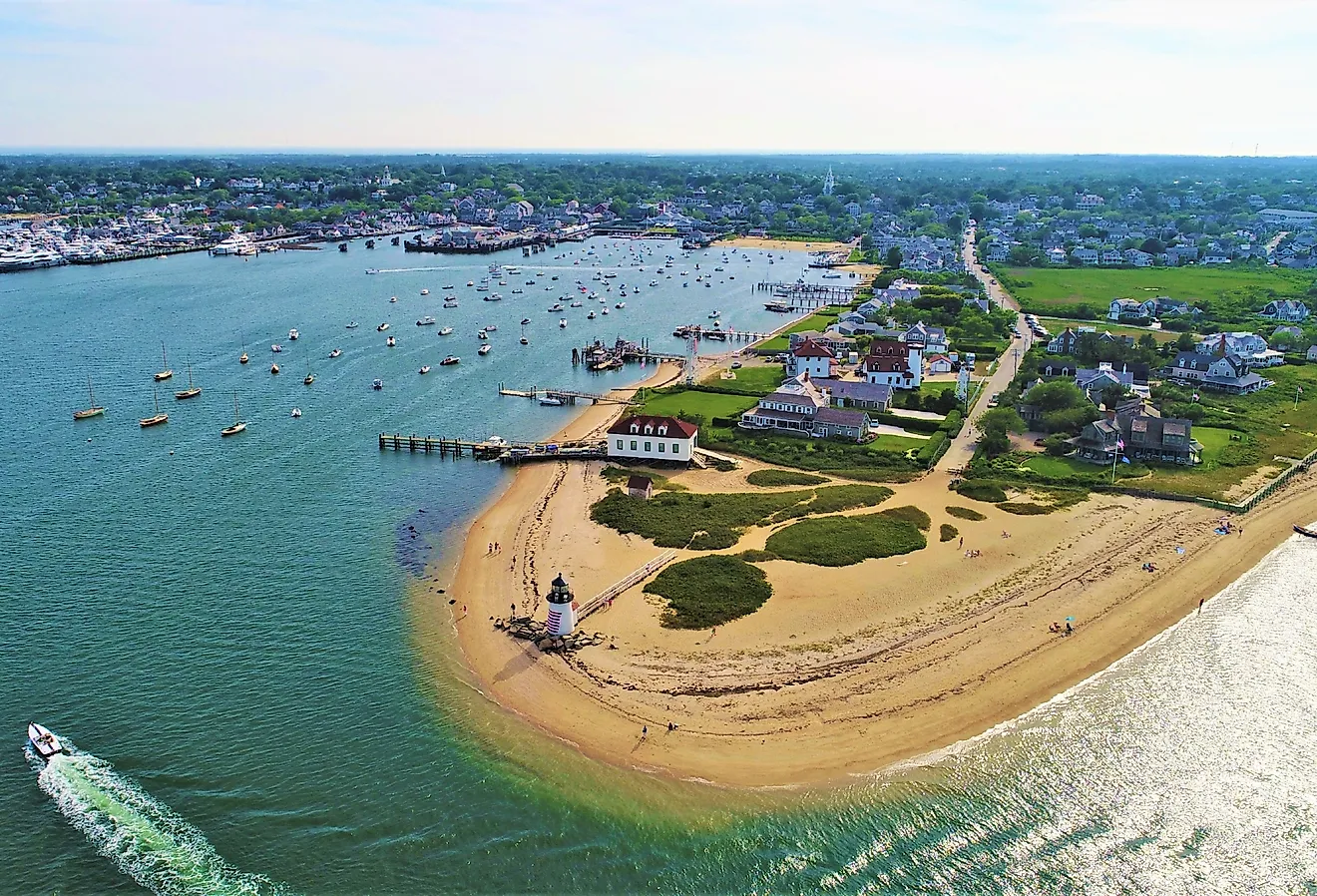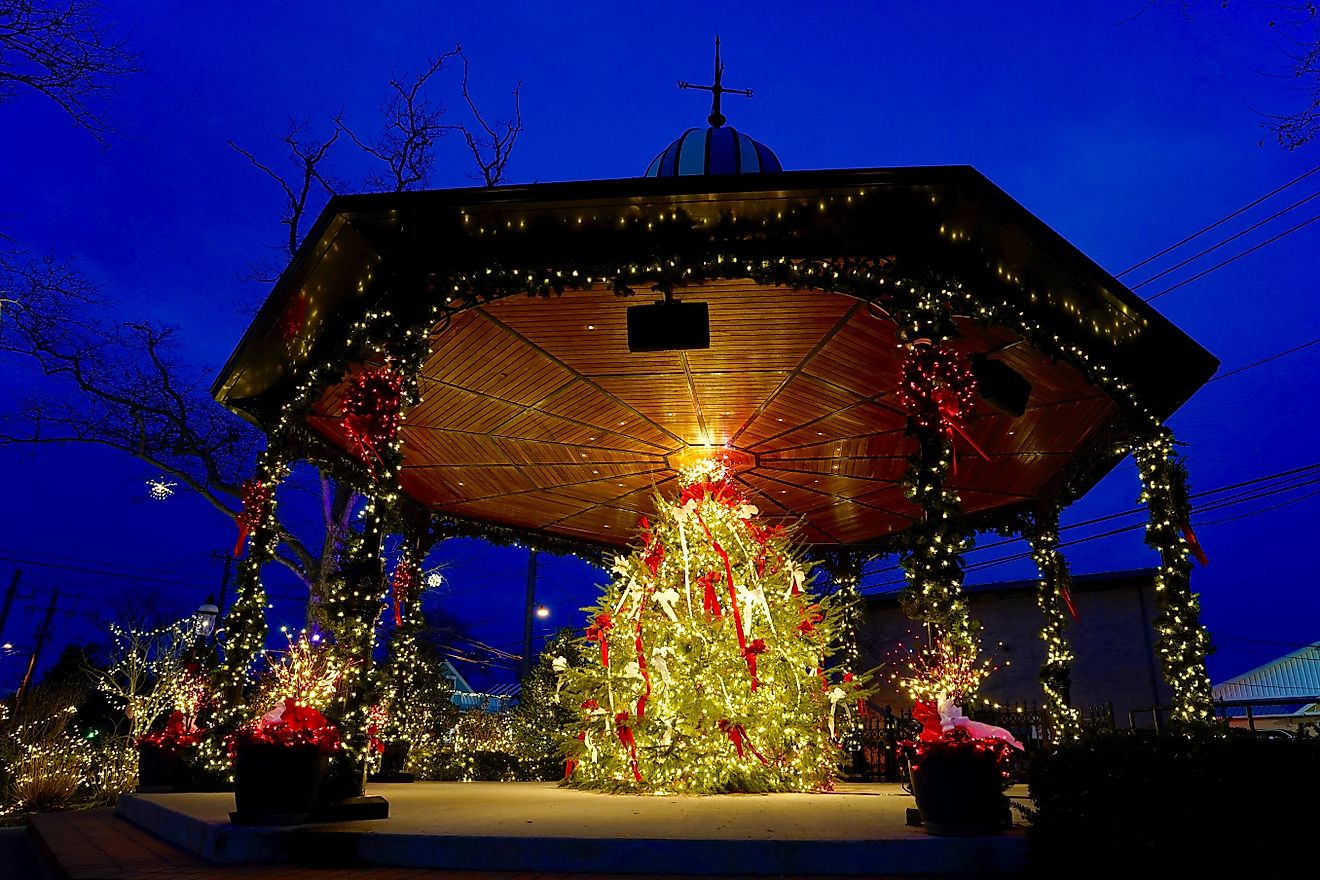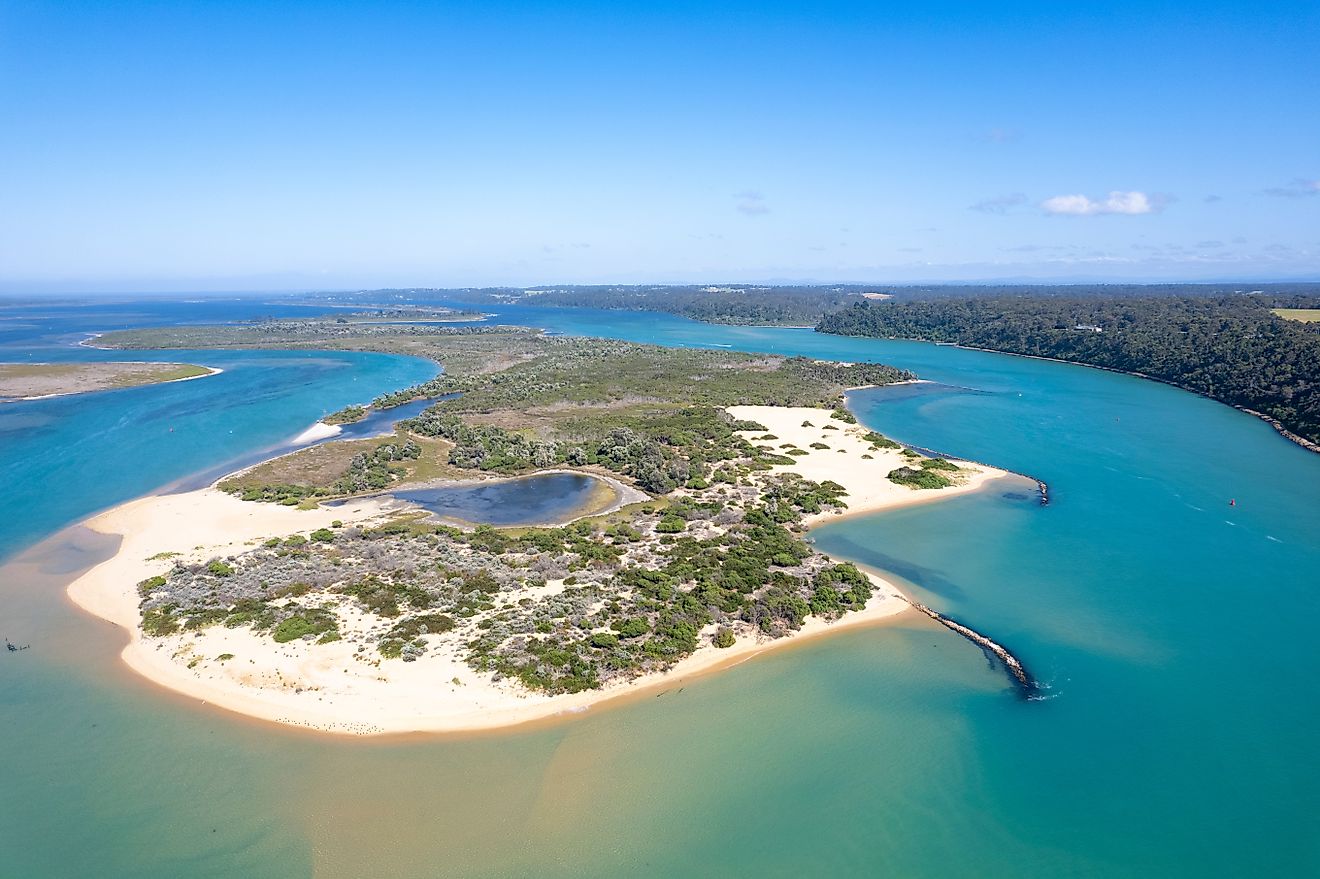Flags, Symbols & Currency of Costa Rica
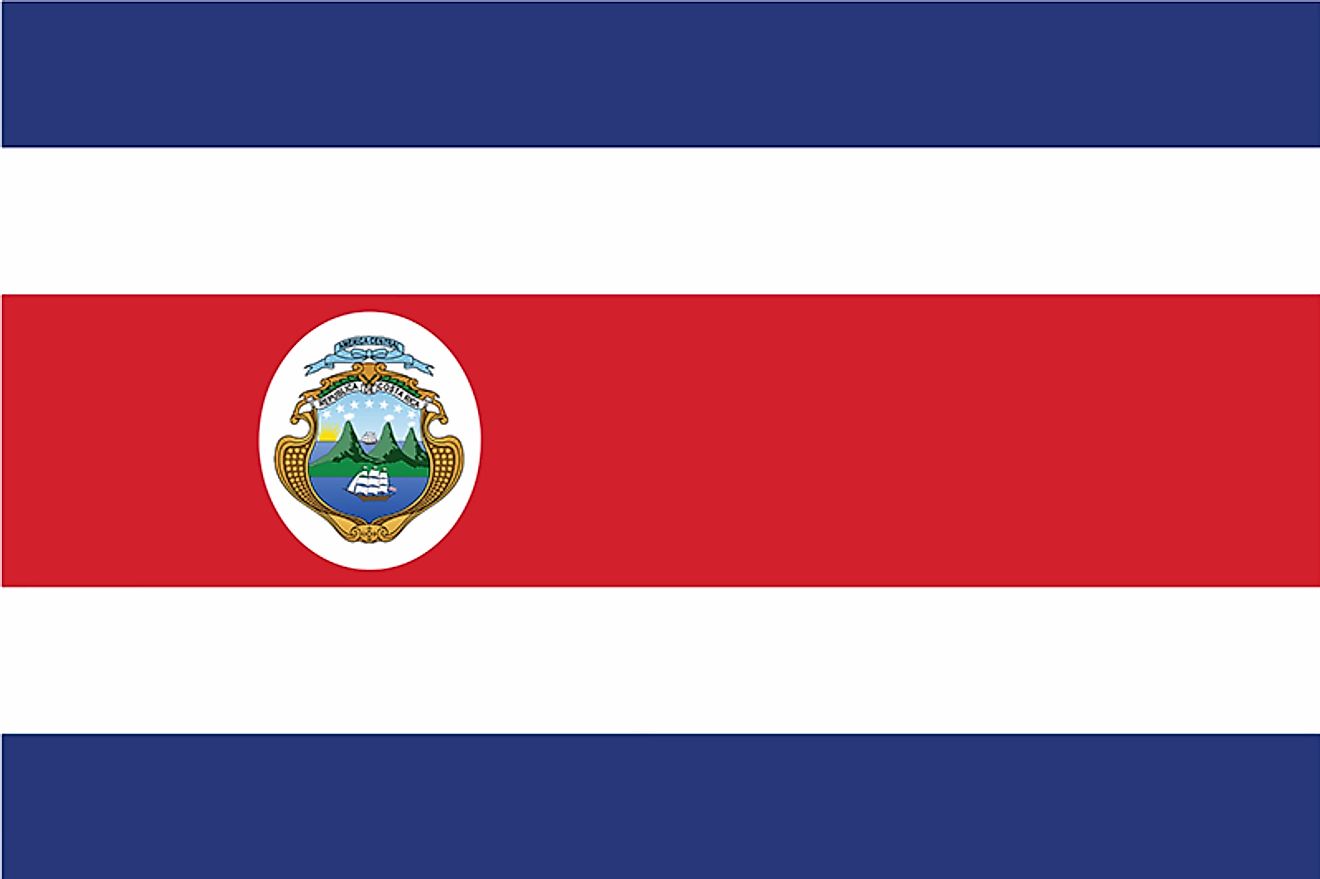
The National Flag of Costa Rica was officially adopted on November 27, 1906. The flag was designed in 1948 by Pacifica Fernandez, the wife of former Costa Rican President José María Castro Madriz. The First Lady was inspired by the colors of the flag of the ‘French Second Republic’ in the aftermath of the 1848 Revolution.
The National flag of Costa Rica is designed as a horizontal rectangle and features five horizontal bands of blue, white, and red. There are two blue bands - one at the top of the flag and another at the bottom, a thicker (double-wide) red band in the center, and two white bands in between. Costa Rica's national coat of arms is found on a white elliptical disk and is placed towards the hoist side of the red band of the flag. The blue color symbolizes the sky, opportunity, idealism, and perseverance. The white color denotes peace, happiness, and wisdom. The red color represents the bloodshed for freedom, as well as the generosity and vibrancy of the Costa Rican people. The five-color stripes are in the ratio of 1:1:2: 1:1. The flag has a length-width proportion ratio of 5:3. The white disk, upon with the coat of arms sits, is absent on Costa Rica’s civil ensign.
History of the Flag of Costa Rica
Being a part of the Spanish Empire, Costa Rica used the Spanish flag until its independence in 1823. Costa Rica joined the Federal Republic of Central America and retained the earlier blue-white-blue flag that was used by the United Provinces of Central America until 1848. In response to revolutionary activity in Europe, it was decided to incorporate the French colors into the national flag and a central red stripe was added to the flag. The Costa Rican flag that was without an emblem was adopted in 1848 and is still currently used as the country’s civil ensign. The design of Costa Rica's flag has been revised twice since its adoption, first in 1964 and again in 1998, to match modifications made to the country's coat of arms. The flag's original design included the coat of arms in the center of the flag, but it was moved toward the hoist edge when the flag was modified in 1906.
Symbols of Costa Rica
The National Coat of Arms of Costa Rica

The National Coat of Arms of Costa Rica features three towering volcanoes representing the country's three mountain ranges and a valley, which rises from a green landscape. A white cloud is featured at the top of each of the three peaks, and the mountains appear to be between two large water bodies, one in the foreground and the other in the background. The two water bodies symbolize the seaports of the Pacific and Atlantic Oceans that surround the island nation. On the two water bodies are sailing two merchant ships with white sails, and each carrying the flag of Costa Rica. The two merchant ships are inspired by the maritime trade that helps to define the country's history. The sun is depicted as rising from the background into a blue sky that includes an arch of seven white, five-pointed stars. The seven white stars stand for each of the country's seven provinces, and the rising sun commemorates the birth of the new nation. The coat of arms is surrounded by a golden frame made up of golden beads, symbolizing the nation’s principal export crop: coffee. The crest is comprised of an azure ribbon with the inscription “Republica De Costa Rica” (Republic of Costa Rica) written in gold. A blue-ribbon featuring the motto “America Central” is placed above the coat of arms.
National Motto
"Pura Vida" ("Pure life")
National Anthem
- Anthem Title: "Himno Nacional de Costa Rica"
- Music Composer: Manuel María Gutiérrez
- Lyricist: José Maria Zeledón Brenes
- Date of Adoption: 1949
"Himno Nacional de Costa Rica" is the national anthem of Costa Rica. The music of the anthem was composed by the Director of the Costa Rican National Army Orchestra - Manuel María Gutiérrez. The lyrics have been authored by José Maria Zeledón Brenes. The music of the anthem was adopted on June 11, 1852. The current lyrics were added in 1903. The anthem was sung and played for the first time on September 15, 1949. The complete anthem were officially recognized as the National Anthem of Costa Rica in 1949.
"Himno Nacional de Costa Rica" (Spanish)
¡Noble patria!, tu hermosa bandera
expresión de tu vida nos da;
bajo el límpido azul de tu cielo
blanca y pura descansa la paz.
En la lucha tenaz, de fecunda labor,
que enrojece del hombre la faz;
conquistaron tus hijos, labriegos sencillos,
eterno prestigio, estima y honor,
¡Salve, oh tierra gentil!
¡Salve, oh madre de amor!
Cuando alguno pretenda tu gloria manchar,
verás a tu pueblo, valiente y viril,
la tosca herramienta en arma trocar.
¡Salve, oh patria!, tu pródigo suelo
dulce abrigo y sustento nos da;
bajo el límpido azul de tu cielo,
¡vivan siempre el trabajo y la paz!
Costa Rican National Anthem
Noble country, our lives
Are revealed in your flying flag;
For in peace, white and pure, we live tranquil
Beneath the clear limpid blue of your sky.
And their faces are ruddy with hard work
In the fields beneath the life giving sun.
Though your sons are but farm workers, their labors eternal
Esteem, renown, and honor have won.
Hail, oh land of our birth!
Hail, oh gracious land we love!
If an enemy seeking to slander you or
Harms your name, then we will abandon our farms
And arise with fervor to take up our arms.
Oh, dear country, our refuge and shelter;
How fertile your life-giving soil!
May your people contented and peaceful
Unmolested continue their hard work.
The Currency of Costa Rica is the Costa Rican colón
The current official currency of Costa Rica is the Costa Rican colón (₡, CRC). The Costa Rican colón is subdivided into 100 centimos, and the currency's plural form is colones.
Coins
The first Costa Rican colón coins were introduced in 1897 and produced in denominations of 2, 5, 10, and 20 colones. The 50 centimos coin made from silver and 2 centimos coins made of cupro-nickel 2 were added in 1903, followed by 5 and 10 centimos coins in 1905, which included the letters G.C.R as an indication that the coins were issued by the government.
Between 1917 and 1919, subunits of the colón were renamed as centavos, rather than centimos. During this time, 5 and 10 centavos coins were issued, and a 50 centavo was produced but not put into circulation.
The government resumed introducing centimo coins in 1920, still bearing letters G.C.R, starting with 5 and 10 centimos coins. In 1923, 25 and 50 centimos coins made from silver, together with the unused 50 centavos coins, came into circulation. In 1925, the production of silver 25 centimos began, and between 1936 and 1941 brass 10 centimos coins were issued.
The production of cupro-nickel coins by the International Bank of Costa (B.I.C.R.) began in 1935, which came in various denomination, and included the letters B.I.C.R. However, between 1937 and 1948, the bank also introduced coins in the same denominations, but with B.N.C.R. printed on them. These denominations included 25 and 50 centimos, and one colon.
Since 1951, the Central Bank of Costa Rica has issued coins with B.C.C.R. printed on them and has also added 5 and 10 centimos coins. In 2009, the larger silver-colored 5, 10, and 20 colón coins were slowly removed from circulation, and replaced with lighter 5 and 10 colón coins and gold-colored 5, 10, 25, 50, 100, and 500 colón coins.
Banknotes
Banknotes were issued by private banks between 1896 to 1914. The Banco Anglo-Costarricense issued notes as early as 1864. The bank was later taken over by the state, but became bankrupt and closed in 1994. Another private bank, Banco de Costa Rica, established in 1890, started issuing banknotes in various denominations of pesos and colóns until 1914.
Gold certificates were issued by the government for various denominations of colones, and silver certificates were issued for 1, 2, 50, and 100 colones and 50 centimos between 1897 and 1917.
Banco Internacional and Banco Nacional issued banknotes of different denominations in 1914. The Banco Central de Costa Rica issued banknotes from 1950 to date, in denominations ranging from 5 to 100 colones.
Historical Currencies of Costa Rica
The Costa Rican peso was the former currency of the country. It was in circulation between 1850 and 1896. Prior to it, the real was the currency of Costa Rica. The real remained in circulation alongside the peso till 1864. The current Costa Rican colón replaced the peso in 1896.
